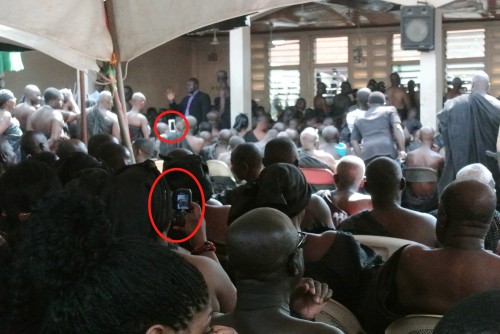
The “digital divide” is a surprisingly durable concept. It has evolved through the years to describe a myriad of economic, social, and technical disparities at various scales across different socioeconomic demographics. Originally it described how people of lower socioeconomic status were unable to access digital networks as readily or easily as more privileged groups. This may have been true a decade ago, but that gap has gotten much smaller. Now authors are cooking up a “new digital divide” based on usage patterns. Forming and maintaining social networks and informal ties, an essential practices for those of limited means, is described as nothing more than shallow entertainment and a waste of time. The third kind of digital divide operates at a global scale; industrialized or “developed” nations have all the cool gadgets and the global south is devoid of all digital infrastructures (both social and technological). The artifacts of digital technology are not only absent, (so the myth goes) but the expertise necessary for fully utilizing these technologies is also nonexistent. Attempts at solving all three kinds of digital divides (especially the third one) usually take a deficit model approach.The deficit model assumes that there are “haves” and “have nots” of technology and expertise. The solution lies in directing more resources to the have nots, thereby remediating the digital disparity. While this is partially grounded in fact, and most attempts are very well-intended, the deficit model is largely wrong. Mobile phones (which are becoming more and more like mobile computers) have put the internet in the hands of millions of people who do not have access to a “full sized” computer. More importantly, computer science, new media literacy, and even the new aesthetic can be found throughout the world in contexts and arrangements that transcend or predate their western counterparts. Ghana is an excellent case study for challenging the common assumptions of technology’s relationship to culture (part 1) and problematizing the historical origins of computer science and the digital aesthetic (part 2).

Last Wednesday, our team attended the “enstoolment” (a ceremony similar to a coronation) of a local chief in the Ashanti region. Tons of people from all around dressed in their finest clothes and converged on the palace grounds to share in the festivities. Some wore traditional toga-like robes, while others dressed in polo shirts and slacks. The court sat on traditional stools, while most of the audience sat on plastic lawn chairs adorned with various Adinkra symbols. Black is the traditional color of formal events, which meant that when audience members took out their smartphones and tablets their lit screens shone like stars. Every few minutes, a new device emerged from underneath handwoven pieces of black cloth. The whole event challenges popular ideas about humans’ relationship to technology and what it does to our existing social habits. Just because there are cameras and internet connections does not mean people are disinclined to show up in person. An enstoolment is meant to happen in a particular place, with a bodily co-present audience. People still find the embodied ceremony meaningful, so they continue to show up and enjoy the ceremony. It is the same reason we still go to concerts even though we have plenty of recorded music- people like being around other people.
I am not trying to idealize or simplify the Ashanti culture, or the role of technology in our lives. Of course everyone doesn’t have a cell phone or an iPad. There are economic disparities in Ghana just like everywhere else in the world, and many people cannot afford a device that records video and puts it on the internet. Similarly, not every person at the enstooling ceremony was enraptured in the ecstatic wonder of ceremony. People made time for the enstoolment like you make time for a wedding or a city council meeting. Some people are more into it than others, some are tired, some were dragged there by a friend who is really into it, and a few felt obliged because their relative was a part of the ceremony. When we start thinking of “culture” as a distinct object, we begin to essentialize it: we turn it into a caricature of itself. An Ashanti businessman filming a royal ceremony with an iPad while dressed in traditional cloth might seem strange, novel, or even contradictory but such reactions are based in a reductionist logic. Culture is much more resilient and dynamic than something that can be dismantled by the very existence of an smartphone. As Clifford Geertz once wrote, “Culture is simply the ensemble of stories we tell ourselves about ourselves.” Those stories can be told in person, and they can be told via text message. The stories will change, and the culture will evolve, but it is up to those that self-identify as Ashanti (or whatever the culture may be) to decide what inventions are compatible with their culture. We heard that modernizing the facilities with indoor plumbing and asphalt roads was a major debate. I think it is safe to assume that there are strong opinions about smartphones as well. We might be tempted to assume that the royalty are the luddites, the keepers of the Old Ways, but one cannot ignore the modern sound system and surveillance cameras that were also installed and utilized.

Even if the have an introductory knowledge of anthropology, most people think of culture as a static object. There are common references in the media to national culture, sports culture, geek culture, online culture, pop culture, and urban culture. Main stream media outlets and popular nonfiction authors play fast and loose with the term, using it as a shorthand for any kind of shared practice, while also confining it to some kind of exorcized other. Culture is something you outgrow (youth culture) or something you visit (Their customs are so unique!) As my previous Geertz quote shows, anthropologists like to point out that our actions are always embedded in culture. From your birthday to how often you do your laundry, culture (perhaps more accurately: cultures) informs what you say and do. Raymond Williams, describes culture as simultaneously significant and mundane:
“We use the word culture in these two senses: to mean a whole way of life–the common meanings; to mean the arts and learning–the special processes of discovery and creative effort. Some writers reserve the word for one or other of these senses; I insist on both, and on the significance of their conjunction. The questions I ask about our culture are questions about deep personal meanings. Culture is ordinary, in every society and in every mind.”

Somehow, open definitions like Williams’ and Geertz’s have led many authors (claiming authority on the subject) to consider information technology as somehow apart from or even against culture. Culture, as the myth goes, is something established in the past and pushes against a constant barrage of modernizing and secularizing forces. We often think of culture as a paradox: on the one hand it is timeless, transcendent, and forms the bedrock of society. On the other it is fragile, easily sullied, and embattled. The former is utilized as a source of national pride, whereas the latter is often used to marginalize others. Technology is seen as the achievement of the strong culture (Technology as Achievement) and the corrupting influence of the weak (Technology as Corruption). Fascistic movements always appeal to the superiority of the national culture. It lasts because it is strong, and it is strong precisely because it can achieve great feats of technoscience. It trains athletes, fosters scientific pursuits, and wins great military victories. Eugenics campaigns were buoyed by the logic of Technology as Achievement. The movie “The Gods Must be Crazy” is an excellent example of Technology as Corruption. Produced and funded by South African apartheid supporters, the “Gods Must be Crazy” movies were made to convince audiences that racial segregation was meant to protect native populations from the corrupting influence of the modern nation state. South African tribes were depicted as child-like imps that lived in a world of natural mysticism. The most minor of intrusions -the existence of a coke bottle- would be enough to destroy their entire culture. Technology As Achievement and Technology as Corruption do not necessarily lead to fascism and apartheid but, taken to their logical extremes and popularly upheld, can justify the worst of atrocities.

Societies have always dealt with the problem of allowing certain kinds of technologies, and prohibiting others. From keeping kosher to outlawing semi-automatic rifles, groups of people must make collective decisions about what tasks can acceptably be delegated to machines and what sorts of human behavior can be augmented with machinery. We shouldn’t treat culture as a static entity: something formed in the past that other people do. When we do treat it as such, we run the risk of falling into the narratives of Technology as Corruption and Technology as Achievement. Anthropologists maintain a broad definition of culture for a reason: it lets us discuss technology as part of culture not outside of it.
The research for this essay was supported by and was originally posted in RPI’s 3Helix Program funded by the National Science Foundation.
You can follow David on twitter: @da_banks

Comments 5
TechnoCultures: Technology as Achievement and Corruption (Part 1 ... | Using Technology to Transform Learning | Scoop.it — July 13, 2012
[...] The third kind of digital divide operates at a global scale; industrialized or “developed” nations have all the cool gadgets and the global south is devoid of all digital infrastructures (both social and technological). [...]
TechnoCultures: Technology as Achievement and Corruption (Part 1 … | Technology and Educational Innovation — July 13, 2012
[...] on thesocietypages.org Share this:ShareLinkedInTwitterStumbleUponEmailTumblrLike this:LikeBe the first to like [...]
TechnoCultures: Technology as Achievement and Corruption (Part 1) | Post-Sapiens, les êtres technologiques | Scoop.it — July 14, 2012
[...] The “digital divide” is a surprisingly durable concept. It has evolved through the years to describe a myriad of economic, social, and technical disparities at various scales across different socioeconomic demographics. Originally it described how people of lower socioeconomic status were unable to access digital networks as readily or easily as more privileged groups. This may have been true a decade ago, but that gap has gotten much smaller. [...]
Technocultures: The Digital Boarderlands (Part 2) » Cyborgology — July 20, 2012
[...] 8. Questions 7 and 6 speak to the TechnoCulture as Corruption or Achievement rhetoric that I introduced last week. Number 5, I am willing to admit, is too blunt to be useful. There is plenty of code to be seen, [...]
TechnoCultures » Cyborgology — August 18, 2012
[...] post combines part 1 and part 2 of “Technocultures”. These posts are observations made during recent field [...]